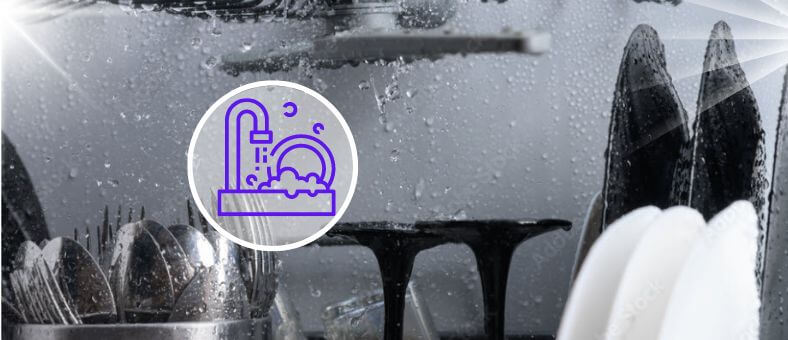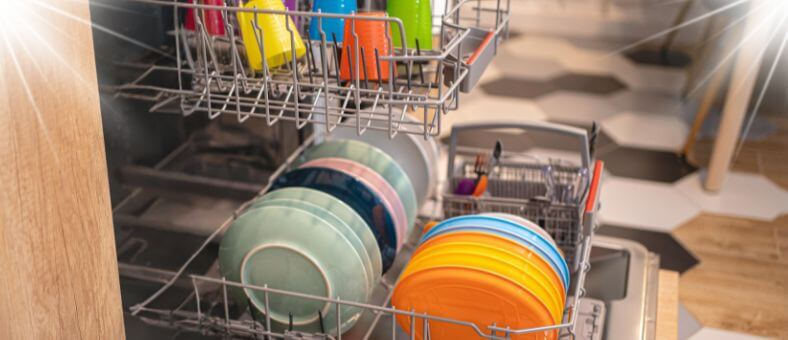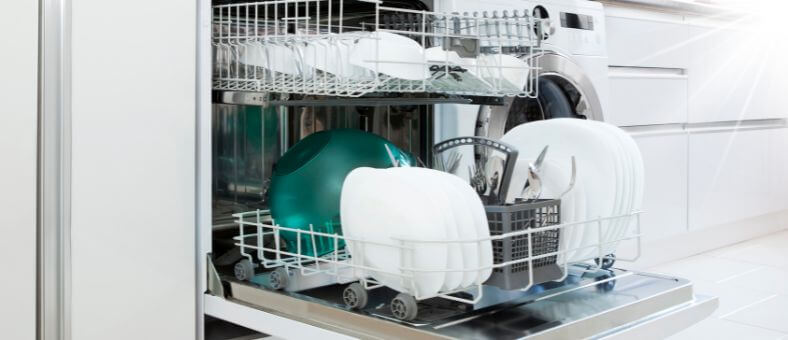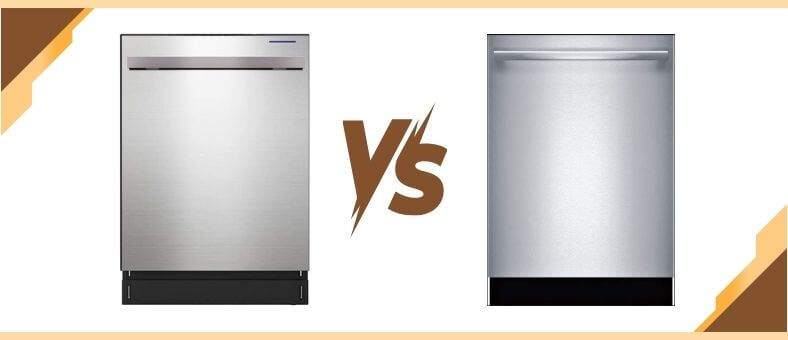Ever pondered while washing dishes, “How much water do dishwashers use?” It’s a common misconception that these machines are wastewater. Modern dishwashers are far from the inefficient giants of the past. Today, they embody sleek design and environmental consciousness. Intriguingly, they often consume less water than the manual washing we’ve been accustomed to. As we delve deeper, you’ll discover that contemporary dishwashers are remarkably water-wise. So, if you’re aiming for an eco-friendly choice or just driven by curiosity, this is your read. Join us in demystifying the water usage of dishwashers, and be prepared for some eye-opening insights.
Dishwashing Days of Yore
The first patented dishwasher in 1850 was hand-operated. But guess what? It wasn’t about water conservation but convenience!
Table of Contents
Comparison: Old vs. New Dishwasher Models
The rate of water consumption by dishwashers has drastically decreased in recent years due to advancements in technology and greater emphasis on water conservation. Modern dishwashers are designed to be more efficient, using significantly less water than older models.
Older dishwasher models, especially those before 1994, used around 10 to 15 gallons of water per cycle. The situation started to change as technological advancements allowed for the design of more efficient models. These older models lacked the energy-efficient settings and advanced washing techniques that today’s models boast.
Fast forward to the present day, and modern dishwashers can perform the same tasks using around 3 to 5 gallons of water per cycle. The newest models have soil sensors, improved spray patterns, and innovative water recycling systems. This all combines to ensure optimal cleaning performance without unnecessary water usage.
Water Consumption in a Standard Dishwasher Cycle
A standard dishwasher cycle in a modern, energy-efficient model typically uses between 3 to 5 gallons of water. This can, however, vary depending on specific factors such as the selected wash cycle and the dishwasher model.
For instance, ‘Heavy’ or ‘Pots and Pans’ cycles are designed to tackle tougher food residue and can therefore use more water. Conversely, ‘Eco’ or ‘Light’ cycles are intended for less soiled dishes and use less water. Some dishwashers also offer a ‘Quick’ cycle that uses less water but is only recommended for lightly soiled loads.
It’s also important to note that the dishwasher model affects water consumption. Some high-end dishwashers have advanced sensors that adjust water usage based on the level of soil on the dishes. Others might include features that allow water to be reused during the pre-rinse cycle in the main wash phase, further conserving water usage. Curious about how these cycles differ and when to use them? Dive into our detailed Dishwasher Cycles and Settings article for a comprehensive understanding.
Understanding the factors that influence your dishwasher’s water usage can help you make informed decisions about its operation, helping you save water and energy while still getting your dishes spotlessly clean. This knowledge is especially crucial in an era where water conservation is increasingly essential.
Factors Influencing Water Consumption in Dishwashers
While the average water usage of dishwashers is significantly lower than a decade ago, individual use can still vary widely. Several factors can influence water consumption in dishwashers, including the dishwasher’s age and model, the chosen settings and programs, the load size, and even the level of food soil on the dishes.
Older dishwashers or those without energy-efficient features may use more water per cycle. Similarly, the chosen setting or program can significantly impact water usage. As mentioned, cycles intended for heavily soiled dishes or pots and pans will generally use more water than a standard or eco cycle.
Overloading the dishwasher or poorly arranging dishes can also result in higher water usage as it may necessitate additional cycles to fully clean the dishes. To ensure optimal efficiency and cleanliness, check out our article How to Load Your Dishwasher Properly for expert tips and techniques.
Average Water Usage by Common Dishwasher Models
Different dishwasher models use varying amounts of water, even when they all adhere to modern efficiency standards. Here are a few examples of common dishwasher models and their approximate water usage:
Standard built-in models
These dishwashers typically use between 3 to 5 gallons of water per cycle. These dishwashers typically use between 3 to 5 gallons of water per cycle. For a deep dive into the features and benefits of these models, refer to our article What is a Built-in Dishwasher.
Compact built-in models
Smaller, compact models may use less water, typically around 3.5 gallons per cycle.
Dishwasher drawers
These dishwashers are perfect for smaller households or as a second dishwasher and use about 1.5 to 2.5 gallons of water per drawer.
How Dishwasher Settings Impact Water Usage
Modern dishwashers have various settings and modes that can significantly impact water usage. Understanding these settings can help you optimize water usage while achieving clean dishes. Here’s a breakdown of some common settings:
Auto or Smart Wash
These modes utilize sensors to determine the level of food soil on the dishes and adjust the water volume and pressure accordingly. This feature ensures that the dishwasher uses just the right amount of water, making it one of the most water-efficient options.
Heavy Wash
This setting is meant for heavily soiled dishes or cookware and uses more water and higher temperatures to ensure a thorough clean.
Light or Eco Wash
These settings use less water and energy, making them suitable for lightly soiled dishes. The water savings come from lower temperatures and less water usage.
Quick Wash
This speedy cycle uses less water but is best used for lightly soiled loads that need to be cleaned quickly.
Impact of Detergent on Dishwasher Water Use
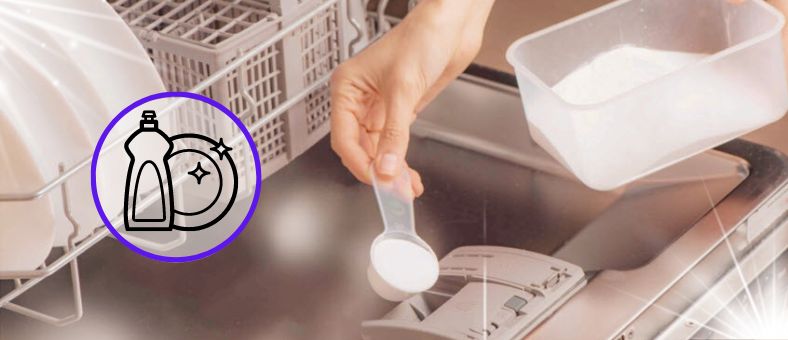
Eco-Waves in the 2000s
The new millennium ushered in a green revolution! Eco-friendly detergents were the in-thing, balancing cleanliness with nature’s care.
The type and amount of detergent used in a dishwasher can notably impact water use and overall efficiency. Here’s a breakdown:
Cleaning Efficacy
High-quality detergents can break down food particles and grease more effectively than their inferior counterparts. If the detergent doesn’t work effectively, users might need to pre-rinse dishes (using more water) or re-wash them, thus consuming more water.
Amount of Detergent
Using more detergent than needed doesn’t necessarily yield cleaner dishes. In fact, excess detergent can leave a filmy residue on dishes, necessitating another wash. Conversely, too little detergent may not clean the dishes effectively, leading to the same outcome.
Phosphate-Free Detergents
Phosphates in detergents can lead to eutrophication in water bodies, depleting oxygen levels and harming aquatic life. While phosphates can improve cleaning, many places have regulations to limit or ban their use due to environmental concerns. Phosphate-free detergents are developed to be effective without environmental drawbacks.
Water Softeners in Detergents
Hard water can lead to mineral buildup in the dishwasher and on dishes, potentially compromising the machine’s efficiency and lifespan. Some detergents come with built-in water softeners to counteract this. Softened water tends to clean more effectively, reducing the chances of re-washing. The adverse effects of hard water don’t stop at residue; it can cause various problems for dishwashers. Fortunately, there are effective ways to address these challenges. Dive into our article Dishwasher Problems Caused by Hard Water and How to Fix Them for a deeper understanding and practical solutions.
Enzymatic Detergents
These contain enzymes that specifically target food particles. They can be particularly effective in breaking down food residues, potentially reducing the need for pre-rinsing and the associated water use. To ensure you’re using the most effective product for your appliance, check out our guide on What is the Best Dishwasher Detergent.
How to Save Water While Using a Dishwasher?
While dishwashers can already be water-efficient, maximizing their potential benefits can lead to greater water conservation and, by extension, significant cost savings. Let’s delve deeper into some methods you can adopt to ensure optimal water usage:
Load it correctly
Positioning your dishes can make a difference. Larger items should be placed at the back and sides of the racks to ensure they don’t obstruct the water flow, allowing each item to be cleaned efficiently. This reduces the likelihood of having to re-wash dishes, thus conserving water.
Choose the right cycle
Your dishwasher has different cycles tailored to the level of cleaning required. Selecting a cycle suitable for the current load’s level of dirt can optimize water usage. Many Energy Star-rated dishwashers have specialized water-saving cycles that clean dishes effectively using less water.
Don’t pre-rinse
Modern dishwashers are powerful. They’re designed to handle food residues without requiring you to rinse the dishes before loading. Instead of rinsing under a running tap, simply scrape off large food particles. This prevents the unnecessary wastage of water and leans into the benefits of low water consumption.
Maintaining Filters for Efficiency
Like any other appliance, your dishwasher needs regular upkeep for optimal performance. This includes cleaning out its filters. A clean filter ensures that the water flow is unhindered and that dishes get cleaned effectively. Moreover, understanding dishwasher water filters and efficiency can illuminate how a well-maintained filter system can lead to cleaner dishes and water conservation.
Cost savings with efficient dishwashers
Investing in a high-quality dishwasher, especially Energy Star-rated dishwashers, can lead to significant savings. These machines are designed for efficiency, reducing both water and power consumption. Over time, the savings on utility bills can be considerable, emphasizing the low water consumption for the environment and your wallet.
Air drying for energy conservation
Letting dishes air dry instead of using the machine’s drying cycle can save energy.After the wash cycle finishes, it’s best to open the dishwasher door so that the steam can escape and the dishes can dry naturally.It’s a simple yet effective method to reduce energy consumption.
Make informed choices
When buying a new dishwasher, do thorough research. Look for those with impressive water and energy efficiency ratings. Many modern machines, particularly Energy Star-rated dishwashers, have features that optimize water usage, leading to environmental and cost benefits.
Consider the dishwasher’s size
Ensure the size of your dishwasher aligns with your needs. For smaller households, a compact model might suffice. It can be more water-efficient than larger models, provided it doesn’t need to run multiple times daily.
Mindful dish use
It might sound simple, but using fewer dishes throughout the day can lead to more irregular washing cycles. This can result in significant water savings over time.
Strategic appliance placement
Ensure your dishwasher isn’t placed next to the refrigerator. The heat from the dishwasher can make the refrigerator work harder, consuming more energy. By placing them apart, you ensure that both appliances work efficiently.
Rise of the Sensors
Advanced dishwashers now come with soil sensors. They measure the dirty dishes and adjust the water level accordingly, ensuring no drop is wasted! Cheers to smart tech!
Water Efficiency: Dishwasher vs. Hand Washing
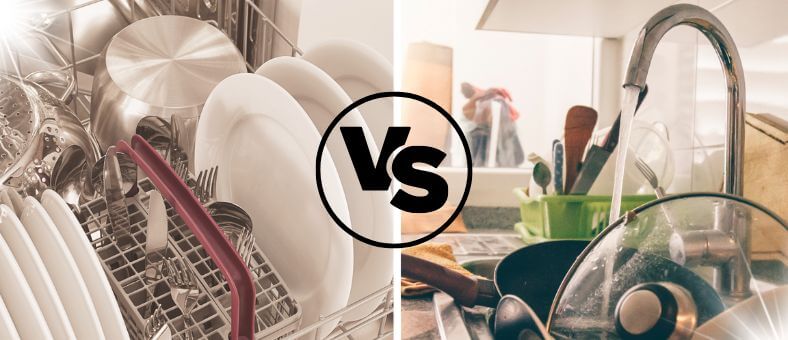
Contrary to the prevailing notion, hand washing your dishes is typically less water-efficient than employing a dishwasher. Modern, technologically advanced dishwashers use about 3-5 gallons of water per load, ensuring dishes are spotless while conserving resources. On the other hand, the traditional hand-washing method can gulp down up to 27 gallons of water for cleaning the same set of dishes.
The disparity becomes even more evident when considering energy consumption: dishwashers are designed to heat only the exact amount of water required for effective cleaning, ensuring maximum energy efficiency. In contrast, hand washing often involves keeping water warm continuously, leading to higher energy costs. Adopting efficient dishwashing practices is essential not just for individual utility savings. Still, it is a pivotal step in reducing water waste in kitchens and making environmentally conscious choices in our daily lives.
The Environmental Impact of Dishwasher Water Usage
Dishwasher water usage has a substantial environmental impact. Beyond the direct use of water, there are indirect factors to consider, like the energy required for water treatment and the water heated for the dishwasher. A high water-usage dishwasher contributes to more significant water demand and, as a result, more energy consumption at treatment facilities.
On the energy front, the amount of electricity or gas used to heat the water for your dishwasher also plays a role. A significant part of the energy used in homes goes into heating water. Dishwashers that use less water also need less energy to heat that water, thereby minimizing their environmental footprint.
Further, dishwasher wastewater goes into the sewage system, requiring treatment before it can be returned to natural water sources. This treatment process also consumes energy and resources, and its effectiveness determines the level of pollution that ends up in our rivers and oceans.
Last Drops: How Much Water Do Dishwashers Use?
Water conservation and efficiency have never been more paramount. As our understanding of the environment and our impact on it deepens, so does our commitment to making sustainable choices. The narrative surrounding dishwashers is a prime example. Far from being water-wasters, modern dishwashers champion efficiency, using as little as 3 to 5 gallons per cycle, while hand washing can consume up to 27 gallons. It’s a compelling argument for the virtues of technology and its ability to harmonize convenience with conservation.
Not only do dishwashers represent a leap in water savings, but they also underscore the significance of energy efficiency, from reducing heating costs to minimizing the environmental footprint. As we navigate our everyday choices, be it washing dishes or larger life decisions, may we always prioritize the environment. After all, every drop of water saved, every watt of energy conserved, ripples outwards in its impact, creating a more sustainable and harmonious world for all.
At WashDryDazzle, we’re dedicated to providing essential insights that make your daily chores effortless. Dive deeper into our comprehensive Dishwasher Education hub to learn more.
Frequently Asked Questions(FAQs)
Which brands are best for water-saving dishwashers?
Some of the top brands known for water-saving dishwashers include Bosch, Whirlpool, Miele, KitchenAid, and LG. These brands have models that feature advanced technology, ensuring efficient water usage without compromising cleaning performance. Always check for the Energy Star certification when seeking a water-efficient dishwasher.
Are water-saving dishwashers more expensive than traditional models?
While some water-saving dishwashers may have a higher upfront cost due to their advanced features, they can lead to long-term savings on water and energy bills.
Do water-saving dishwashers also save on electricity?
Yes, many water-saving dishwashers are also energy-efficient. By using less water, they require less energy to heat the water, leading to electricity savings.
What are water conservation techniques in appliances?
Water conservation techniques in appliances refer to the methods and technologies implemented in household devices to reduce water consumption and wastage.
Why is it important to have water-efficient appliances in the home?
Water-efficient appliances save on water bills and help conserve our planet’s most vital resource. They reduce the strain on local water supplies and wastewater treatment facilities.
Which household appliances use the most water?
Typically, toilets, washing machines, dishwashers, and showers are among a home’s top water-consuming appliances and fixtures.
How can I tell if an appliance is water-efficient?
Look for certifications like the EPA’s WaterSense or Energy Star labels. These certifications indicate that the product meets specific efficiency standards.

